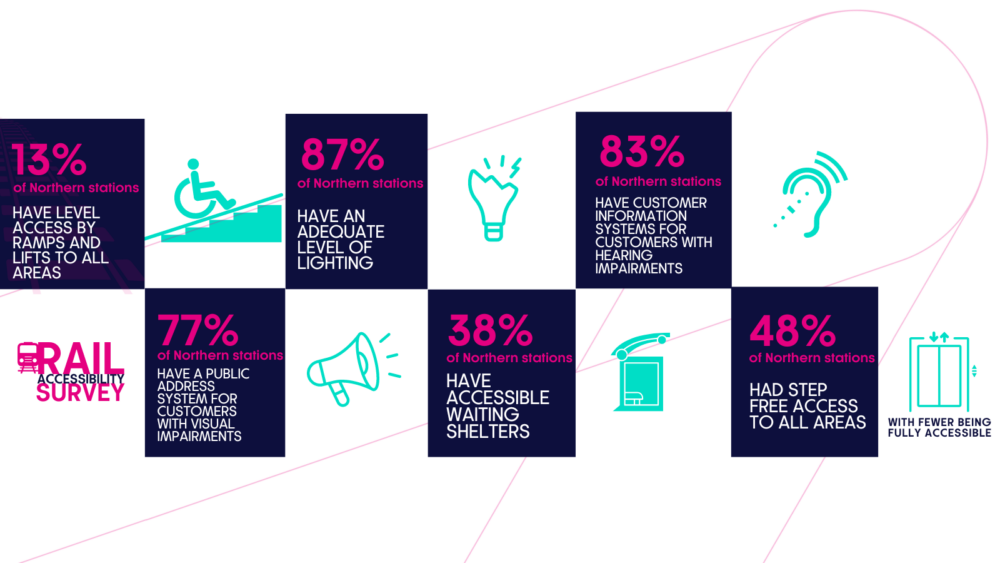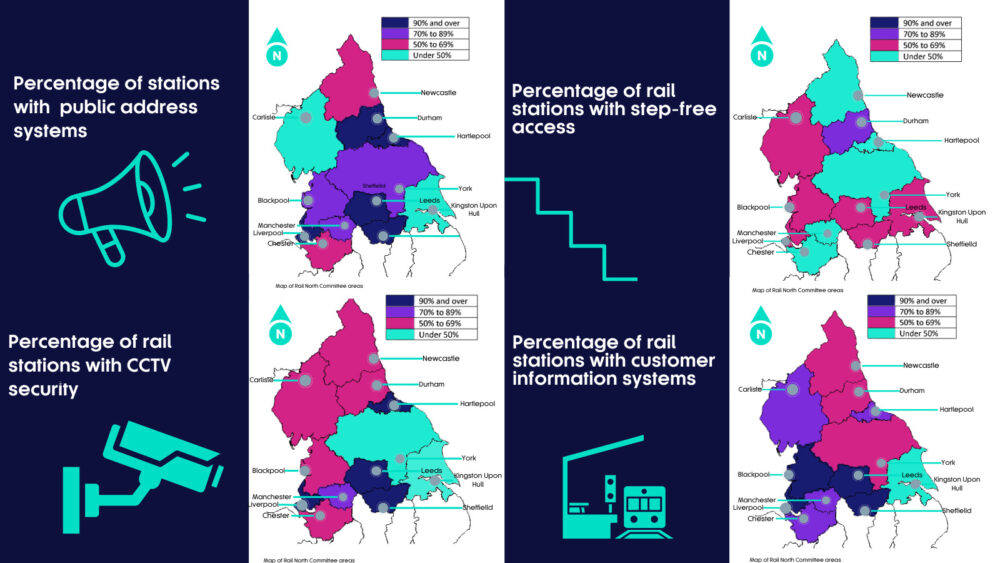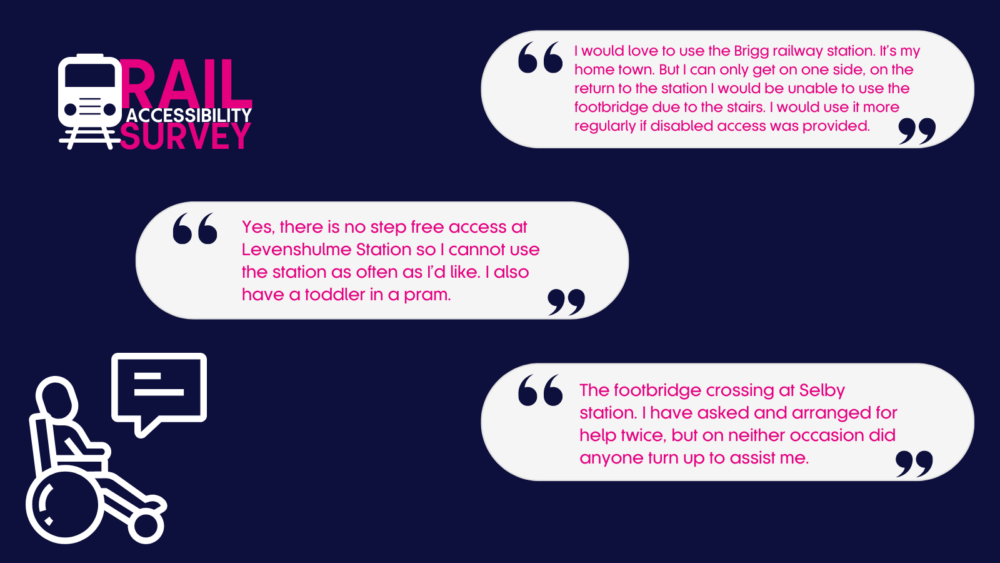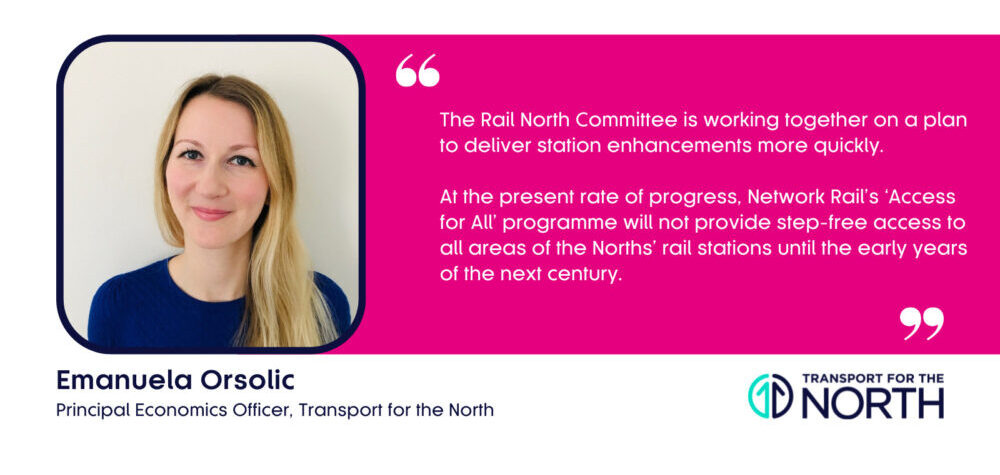We caught up with Emanuela Orsolic, Principal Economics Officer, about our Rail Accessibility Survey, and how you can have have your say…
When it comes to the North’s rail system, the current lack of accessibility at many of the North’s stations presents a significant barrier to residents travelling by rail more often, or even travelling by rail at all. Some of the North’s rail stations are still partially or wholly inaccessible to people with disabilities or reduced mobility.
We are determined to change that. To deliver a fully inclusive transport system, we need public transport, including rail travel, to be more affordable, more reliable, safer, better integrated with other modes of travel, and more accessible to all population groups.
Rail North Committee and other regional stakeholders are concerned about both the poor overall state of accessibility for passengers with mobility and sensory impairments, and the considerable variation in the provision of different types of facilities. TfN’s analysis of facilities at 600 rail stations in the North found that…

A particular focus of concern is that only about half of our stations enable step-free access to all areas for persons of reduced mobility. The maps below also show that the provision of equipment necessary for inclusive access at rail stations varies significantly between the counties which make up the North. The maps illustrate that rural areas of the North are particularly likely to have poor levels of accessibility at rail stations.

The Rail North Committee is working together on a plan to deliver station enhancements more quickly. At the present rate of progress, Network Rail’s ‘Access for All’ programme will not provide step-free access to all areas of the Norths’ rail stations until the early years of the next century (Transport for the North, Strategic Rail Report, May 2023).
Previous analysis undertaken for TfN has estimated that bringing all of the North’s stations to a high standard of inclusivity – with step-free access, customer information and public address systems, and CCTV security provided at every station – would cost £1,451 million (2021 prices), but over 30 years would provide a higher return in social and economic benefits than the net investment cost (Mott MacDonald, for TfN, Northern England Station Enhancements Programme: Strategic Outline Business Case, May 2022).
But accessibility isn’t just about being able to physically get into a rail station. It’s also about things like being able to afford to travel on rail, being able to get to a rail station safely and comfortably, being able to move around the station easily, being able to access the required information when travelling, and feeling safe and comfortable while waiting for the train service, as well as onboard the train.
Poor accessibility at stations can impact a passenger’s rail journey in many negative ways, from a lack of comfort, to causing increased stress and anxiety, or exacerbating the discomfort or pain from physical or mental health conditions. For some passengers, a lack of accessibility can mean the difference between making a journey and staying at home, or making a journey with the risk of becoming stranded, trapped, or having to significantly prolong their journey to get to an accessible station.
When stations are not fully accessible, many passengers, particularly passengers with disabilities, rely on staff for support and assistance, however over half (58%) of the rail stations in the North are completely unstaffed, potentially cutting off passengers with disabilities or other accessibility challenges from access to the rail network from the station nearest to their home (or having to extend the overall length of the journey to board from a more accessible or better staffed station).
This means that many passengers with disabilities may avoid travelling on rail unless essential, potentially increasing feelings of loneliness, isolation or social exclusion. N
ationally, individuals who experience a long-term condition or illness which significantly reduces their ability to carry out day-to-day activities undertake 5 trips on rail per year on average, compared to individuals without a long-term condition or illness who undertake 20 trips on rail per year (Department for Transport, National Travel Survey, 2022).
Research from Transport for All found that disabled people make far fewer journeys than non-disabled people, with an average of just 5.84 journeys per week across all modes of travel, a third of the national average of 17 trips a week. The study found that 44% of respondents with disabilities want to travel more than they currently do, and if transport was made fully accessible, they would like to make more than 10 trips per week, suggesting that removing barriers to travel for individuals with disabilities could increase the number of trips they make by 50% (Transport for All, Are we there yet? Barriers to transport for disabled people in 2023, December 2023).
We recognise that understanding the experiences of rail passengers, and particularly their experiences of the accessibility of rail journeys, is crucial to identifying where accessibility improvements are most needed on the North’s rail network.
That’s why we have launched a new survey to better understand passengers’ views about accessibility at rail stations in the North. The survey is open to everyone who travels on rail within the North. It asks people to give feedback on the level of accessibility they have experienced at a specific rail station in the North.
The survey invites rail users to comment on the accessibility of different aspects of the station environment, and on different stages of using a station (starting from arriving at a rail station, to boarding a train for their onward journey). If they wish, rail users can complete the survey multiple times to provide comments on multiple stations that they use.
So far, we have received over 1,000 responses from rail users in the North. Below are just a few of the comments we have heard so far.

We hope our survey will help us to gather views on accessibility from rail users on as many rail stations in the North as possible.
TfN will use the insights gathered via the survey to help inform plans for accessibility improvements to our rail stations, developed in collaboration with our industry partners.
So give us your views now on your local station, or indeed any station that you use, by 7 June 2024, and help us to address these issues so we can make rail truly accessible for all.
